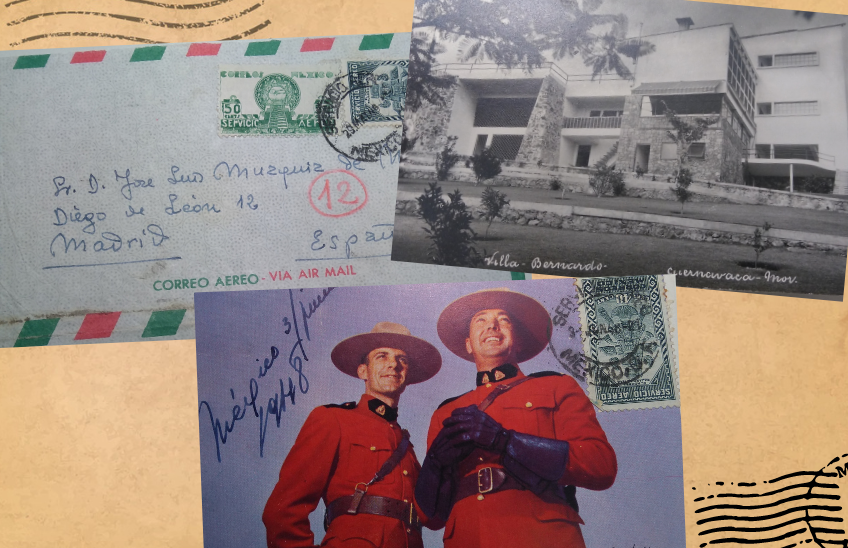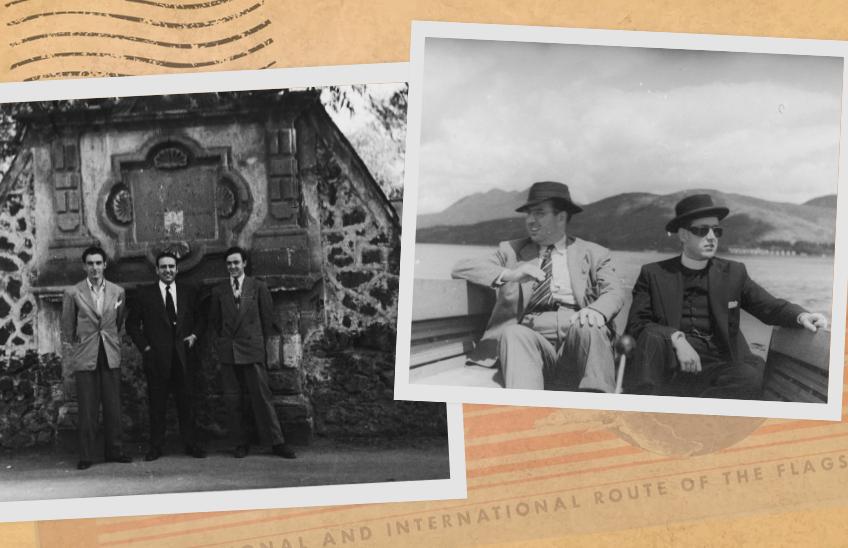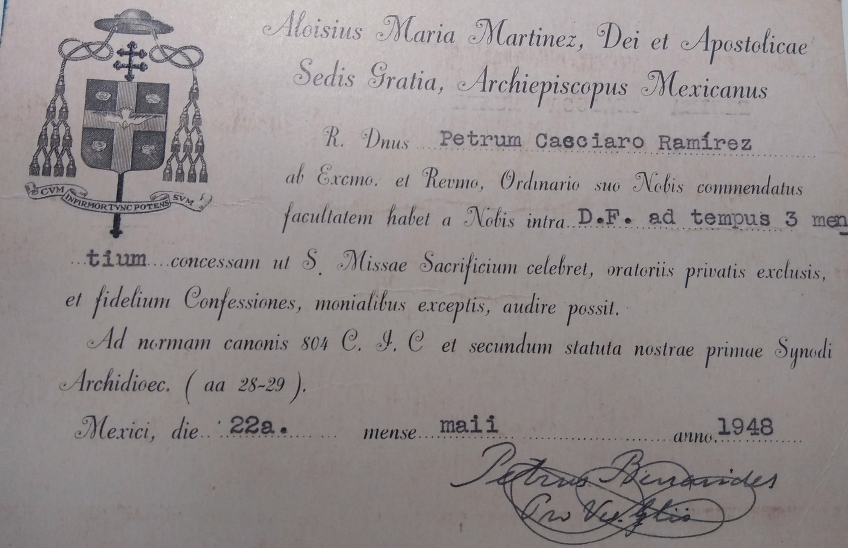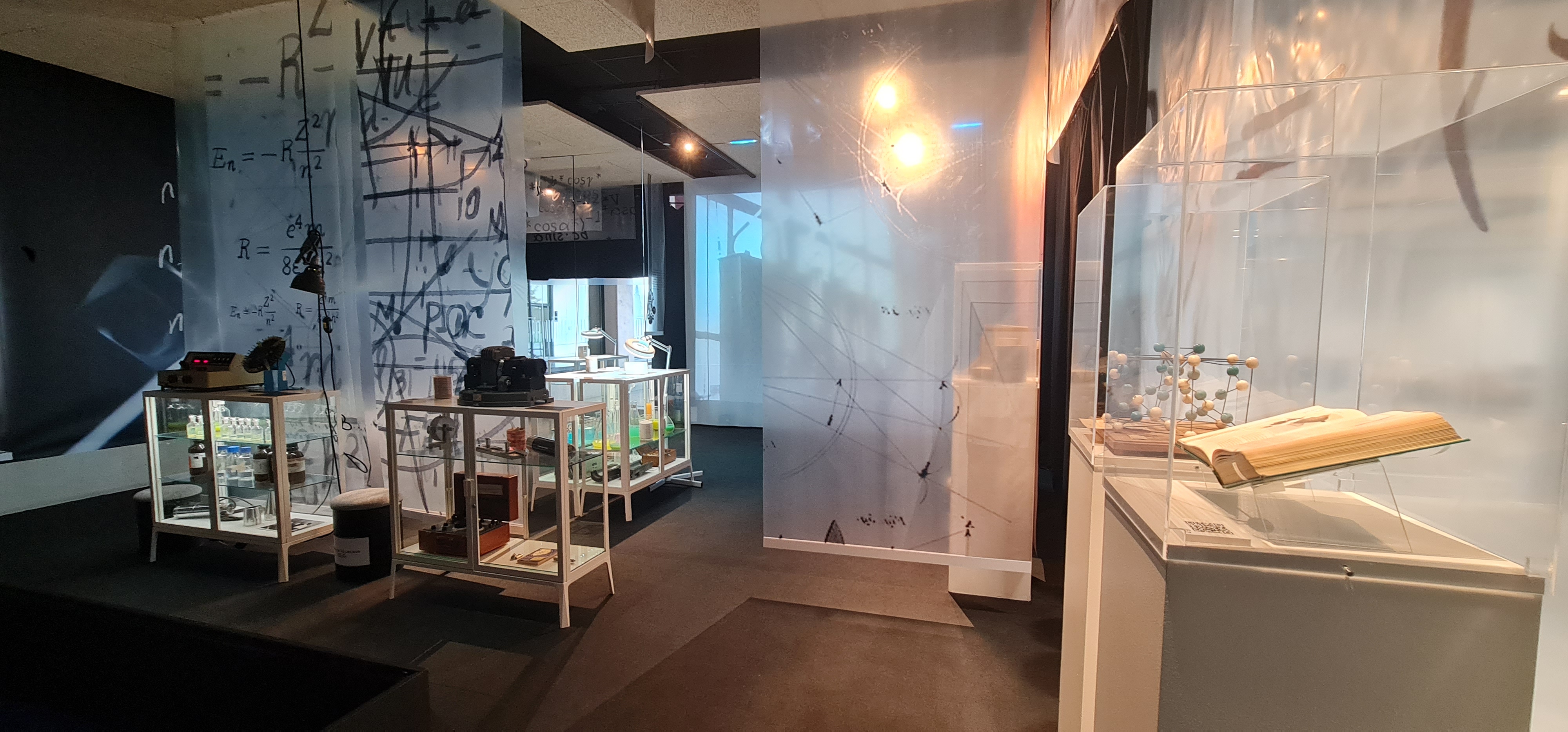75 years of Pedro Casciaro's first pilgrimage in Mexico
Chronicle of the trip through America (Part: 1): In May 1948, the priest Pedro Casciaro made, together with two young professors who accompanied him on his trip through America, his first pilgrimage in Mexico. Before the image of Our Lady of Guadalupe, the three of them prayed for the future of Opus Dei in those lands.

30 | 05 | 2023
On Sunday, May 30, 1948, the priest Pedro Casciaro together with two young Spanish professors, Ignacio de la Concha and José Vila, prayed their first pilgrimage on Mexican soil. In their travel diary they noted:
"We went to the village, to the basilica of the Virgin of Guadalupe. It was full of people. There we prayed our part [of the rosary], on our knees. I can't know what we all asked for, the three of us, in this first American pilgrimage. But I think it is easy to guess: proselytism, prospects for work, the future of the Work, here and there. In every place and in every class and condition. We ask, we ask for everything, and truly the day consecrated to the Lady has been noticed".
The three travelers had arrived in Mexico a few days earlier on an exploratory trip that the founder of Opus Dei had entrusted to them with the purpose of evaluating the possibilities of expansion of the Work in the American continent, goal .
At that time Opus Dei had begun to spread its apostolates throughout different countries. Although it had grown gradually since its foundation in 1928, the end of the Second World War opened a new panorama that allowed freedom of movement through the former war scenarios and with it the possibility of transmitting the message of sanctification through the daily work throughout the world.
Its first steps outside Spain took place on the European continent: Portugal, Italy, France, the United Kingdom and Ireland. Little by little Opus Dei grew geographically and numerically: its members reached about 800 by the middle of the 20th century. The institution was also beginning to be known among some bishops, who showed increasing interest in the Work beginning its apostolates in their respective dioceses.
In 1948, the founder felt it was time to leave Europe. For this reason, he entrusted the priest Pedro Casciaro, the Full Professor of History of Law of the University of Valencia Ignacio de la Concha, and the graduate in Philosophy and Letters José Vila to make a trip to trace the rhythm of the future expansion. Their mission statement was to select the places and meet the people who could be involved in the project.
After making the necessary preparations and arrangements, on April 13, 1948, the three of them left Madrid for New York. They spent the first five weeks of the trip visiting several cities in the United States and Canada. There they met with bishops from both countries, the Vatican's apostolic delegate in Canada and some academic colleagues of José María González Barredo, another member of Opus Dei who had been working in the United States since 1946.
The third destination of these explorers was Mexico. They arrived on May 19 at the Mexico City airfield. From the very first moment they perceived the broad apostolic horizons of those lands. For this reason, their stay extended for almost three months, which is equivalent to half the time they spent in America. During their stay, they visited several cities and met with bishops, priests and lay people.

Visits to Mexican ecclesiastics
One of the main objectives of the trip was to meet with ecclesiastical authorities, especially bishops, to explain to them what Opus Dei was all about. As Pedro Casciaro was the only priest among the three travelers, he was given the task.
During his trip to America, Casciaro met with a total of 66 prelates and clerics. In these meetings, the Spanish priest introduced them to Opus Dei, gave them an informative grade in Latin and conveyed the Founder's desire to start working there as soon as possible.
These interviews were documented in the travel diary that the explorers carried with them. In addition, Casciaro transmitted to the founder the details of these encounters in his frequent letters, and the good disposition and openness he found in all the American bishops.
Mexico was the country where Pedro Casciaro met the most ecclesiastics. He met a total of 22 of them, of all of them he took away a pleasant impression and with some he managed to meet more than once.
From the first days, the Bishop of Mexico City, Luis Maria Martinez, was very happy with the arrival of the three members of Opus Dei. In one of their meetings he granted them licence and indulgence for the spreading of private devotion to Isidoro Zorzano, a member of the Work who was born in Argentina at the beginning of the century and died in 1943 in Spain with a reputation for sanctity. In another of the meetings with the Archbishop, the travelers described him as "very affectionate and eager for us to start working here, he wanted us to stay here now".

Permission granted by the Archbishop of Mexico to Pedro Casciaro.
Before completing the first month of their stay in Mexico, the three travelers went to Yucatan, where they held several interviews and made interesting contacts for the future. The archbishop was Fernando Ruiz Solórzano, whom Casciaro had met a few months earlier in Spain. On that occasion he had explained to him what the Work was; and now Casciaro was able to talk with him in greater depth. In the travel diary they noted:
"We were a little uneasy in the morning, waiting for this afternoon's meeting with the Archbishop.
And it was really great. Peter went alone to see him. I will summarize.
That we go because he has work for us, because he has thought that it is a blessing that the Work begins to work in his archdiocese, because due to the peculiar way of working of the Work, it is what Yucatan needs. That he will give us a house, that as long as he has [,] nothing will be lacking for us economically".
Casciaro also saw the Archbishop of Puebla, Msgr. José Ignacio Márquez y Tóriz, who received him twice. The diary reads: "We chatted for two hours, a general conversation about the Work, the university, the spiritual problems of Mexico (...) He kept the form about the Work".
The Spanish priest was very impressed to see that Bishop José Ignacio Márquez y Tóriz understood well the apostolate carried out by the members of Opus Dei. José Ignacio Márquez y Tóriz understood well the apostolate carried out by the members of Opus Dei, as well as the ample opportunities to contribute to the apostolic work with the university students in Puebla. The day after meeting, the travelers' diary again mentions:
"Last night, the Archbishop made an extremely pleasant impression on us. He has all the characteristics of a holy man, ready to understand the importance of the Work".
During their visit to Guadalajara, they also found a promising outlook. Although they were only there for three days, July 25-28, they took the opportunity to meet with various people and get to know the School of Engineering and the Autonomous University of Guadalajara. They also made appointments with the bishops of Guadalajara and Zamora. During their interview with the bishop of Guadalajara, they talked extensively about the apostolate carried out by Opus Dei. In their diary, they recorded the following:
"He was very warm and friendly, he did not have many ideas of the Work, and he is concerned that it does not clash with anything already established. He believes that a lot of work can be done in Mexico. He kept a brochure and recommended that we talk to several prelates, among them the one in Zamora. He assumes that they will talk about the Work in the next meeting that they will have in Mexico, on the occasion of the silver jubilee of the Archbishop there, and he thinks that it would be convenient for us to know about it beforehand. He dedicated a photograph to us and told us that he would be very happy to talk to us at length on a trip he plans to make next week to the capital.
Following the recommendations of the Bishop of Guadalajara, the travelers were able to meet, the following day, with the Bishop of Zamora, José Gabriel Anaya y Díez de Bonilla, who "was very interested in the Work".

Back to Mexico
The three young explorers returned to Spain in September 1948. A few months later the founder entrusted Pedro Casciaro with another trip. This time he wanted him to begin the stable work of Opus Dei in Mexico. He was to be joined by his former traveling companion, Ignacio de la Concha, and engineer José Grinda.
Before leaving, the travelers said good-bye to St. Josemaría Escrivá in Molinoviejo, who told them: "This blessing and an image of our Lady is all I can give you to get you started in Mexico.
The contacts and friendships that Casciaro and De la Concha had made on their exploratory trip in 48 were very useful to take the first steps, although there were many difficulties along the way. A few years later, Pedro Casciaro recalled:
"I will only say, in general terms, that the beginning of the apostolic work of Opus Dei in Mexico had the difficulties characteristic of all beginnings: we had to solve the economic problem, we did not know whether or not we would obtain permission from residency program in the country and, in short, a long etcetera."
From the very first moment, they were accompanied by the blessing and affection of several bishops who supported the arrival of Opus Dei. Among them was the Archbishop of Mexico, Monsignor Luis Maria Martinez, who wanted to celebrate the first Mass in the apartment they had rented at 33 Londres Street. There, on March 19, 1949, he left the Eucharist in the chapel, which was installed in the best room of the apartment. Also the Archbishop of Yucatan, Fernando Ruiz Solorzano, was of great financial aid in those beginnings. He also wrote the prologue to the first Mexican edition of The Way, published by the founder of the Work in 1939, whose first Mexican edition came off the press the year after the first arrival in Mexico of those three members of Opus Dei.
_______________
Related content:
Episode of the 'Fragments of History' podcast: The scouts. A long journey through America
'Studia et Documenta': The scouts. A long journey in 1948 to prepare for the arrival of Opus Dei in America.




